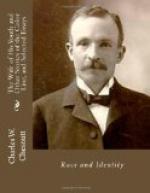In a later case the court held: “The question whether persons are colored or white, where color or feature are doubtful, is for the jury to decide by reputation, by reception into society, and by their exercise of the privileges of the white man, as well as by admixture of blood.”
It is an interesting question why such should have been, and should still be, for that matter, the law of South Carolina, and why there should exist in that state a condition of public opinion which would accept such a law. Perhaps it may be attributed to the fact that the colored population of South Carolina always outnumbered the white population, and the eagerness of the latter to recruit their ranks was sufficient to overcome in some measure their prejudice against the Negro blood. It is certainly true that the color-line is, in practice as in law, more loosely drawn in South Carolina than in any other Southern State, and that no inconsiderable element of the population of that state consists of these legal white persons, who were either born in the state, or, attracted thither by this feature of the laws, have come in from surrounding states, and, forsaking home and kindred, have taken their social position as white people. A reasonable degree of reticence in regard to one’s antecedents is, however, usual in such cases.
Before the War the color-line, as fixed by law, regulated in theory the civil and political status of persons of color. What that status was, was expressed in the Dred Scott decision. But since the War, or rather since the enfranchisement of the colored people, these laws have been mainly confined—in theory, be it always remembered—to the regulation of the intercourse of the races in schools and in the marriage relation. The extension of the color-line to places of public entertainment and resort, to inns and public highways, is in most states entirely a matter of custom. A colored man can sue in the courts of any Southern State for the violation of his common-law rights, and recover damages of say fifty cents without costs. A colored minister who sued a Baltimore steamboat company a few weeks ago for refusing him first-class accommodation, he having paid first-class fare, did not even meet with that measure of success; the learned judge, a Federal judge by the way, held that the plaintiff’s rights had been invaded, and that he had suffered humiliation at the hands of the defendant company, but that “the humiliation was not sufficient to entitle him to damages.” And the learned judge dismissed the action without costs to either party.




